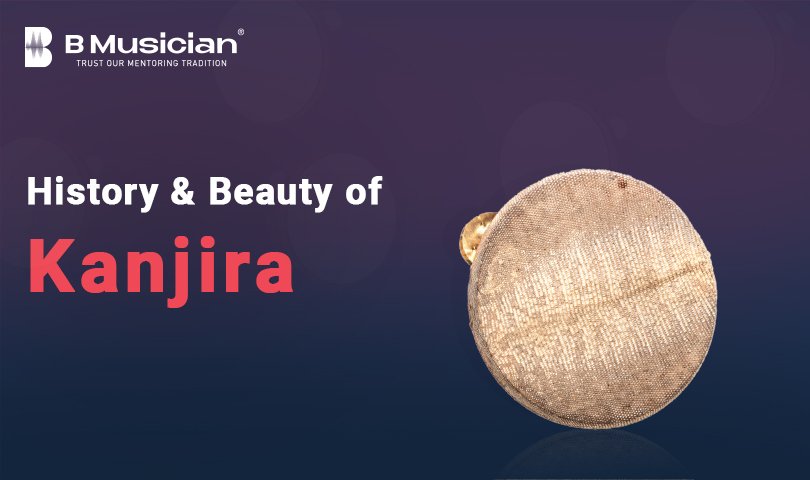Origin of the South Indian Hand Drum:
The Kanjira is part of the ancient musical traditions of South India, specifically within the Carnatic music system. Its origins can be tracked back to the classical music practices of of the region, where it has been used as percussive instrument for centuries. The Kanjira’s emergence in South Indian Carnatic music, as well as the development of modern form of instrument is credited to “Manpoondia Pillai” who was a temple lantern bearer in 1880s who sought to study Kanjira Lessons and master hand drumming. He modified the Kanjira’s frame with a single pair of jingles and brought the instrument to a classical stage.
Kanjira is primarily classified as a Upa- Pakavadhya, as the term suggests Upa meaning – sub and paka means secondary, – translating into secondary percussive instrument.
The Upa Pakavadhya in a Carnatic ensemble plays a secondary or a supportive role. They are meant to compliment the primary percussive instrument like the Mridangam.
The other Upa Pakavadhyams commonly in use are: Morsing, Ghatam, Kollu, Chenda etc.
Historical records and ancient texts indicate that the Kanjira has been in use since at least the 16th century. It is closely associated with the music of South India and has been a staple in both classical performances and folk traditions.
In Nepal Kanjira is called as Khaijadi, the country has a variety of tambourines beside Kanjira including Daanf, Damphu, and Hring.
Physical Description and Construction:
The Kanjira structurally is a small- hand held drum with circular frame typically made of wood or metal. It has a single drumhead made from lizard skin or synthetic materials. The drumhead is stretched over the frame and can be tuned by adjusting tension.
The drum is played with one’s fingers and palm, producing a variety of rhythmic patterns and tones. The player holds the drum with one hand while striking it with the other hand.
The Kanjira produces a sharp, resonant sound that is both vibrant and versatile. ITs tonal range can evoke a variety of emotions from deep and meditate to lively and energetic. Its tone is characterised by a mix of high pitched, treble heavy notes and a deep resonant bass note when played with the palm.
Development and Evolution of the Kanjira:
Over time the Kanjira has undergone various modifications. Originally it was made with a frame of wood and lizard skin, but modern versions sometimes use synthetic materials for drumhead and frame.
Early versions of Kanjira were likely made from natural materials, including wood and animal skins. These instruments were used in religious ceremonies, folk performances, and classical music contexts.
Later, advancements in technology have allowed for more precise manufacturing techniques. Modern kanjira are often crafted with the help of machinery, ensuring uniformity and high quality construction.
Some contemporary kanjiras come with adjustable tension mechanisms, allowing players to fine tune the drumhead more easily compared to traditional methods.
Modern Kanjira players have developed new techniques and rhythmic patterns, expanding the instrument’s expressive capabilities. This includes complex finger techniques and innovative rhythmic variations.
The Kanjira has been integrated into various musical ensembles, including traditional Carnatic music, as well as fusion music and contemporary music genres. Its distinct sound and rhythmic versatility have made it a valued instrument in both classical and popular music settings.
Role in Musical Concerts:
In Carnatic music the Kanjira serves as an accompaniment to the vocal and instrumental performances. It plays a crucial role in maintaining the rhythm and adding texture to the musical performance.
Besides classical music the Kanjira is also used in various folk traditions across South India, where it often accompanies dance and storytelling.
Today, the Kanjira is appreciated not only for its traditional uses but also for its adaptability in modern musical contexts. It is featured in fusion music, world music ensembles and even in experimental genres.
Notable Performers/ Musicians who had traveled with the Kanjira:
Several accomplished Kanjira players have contributed to its prominence in Carnatic music. These artists are known for their mastery of the instrument and their ability to push the boundaries of its traditional use. Their performances often highlight the Kanjira’s versatility and its vital role in the rhythmic structure of Carnatic Music.
Here is a list of Maestros and legend in Kanjira who were widely known for their contributions and works in propagating the instrument through history and time:
Dakshinamoorthy Pillai: was a leading mridajngam artist and a Kanjira artist. He was the student of Manpoondiya Pillai and was influenced by the music of Thanjavur Krishna bagavathar.
T.H Subash Chandran: is renowned for his deep understanding of rhythm and his influence on the art of kanjira playing. His innovative techniques and performances have earned him a prominent place in Carnatic music.
Nagarajan: A revered kanjira player known for his mastery of traditional rhythms. V. Nagarajan’s techniques have significantly influenced modern kanjira playing and have been passed down to his son, V. Selvaganesh.
Selvaganesh: the son of the late V. Nagarajan, is celebrated for his pioneering contributions to the kanjira and his ability to blend traditional rhythms with contemporary styles.
Known for his international performances and collaborations, he has expanded the kanjira’s role in both classical and fusion music contexts.
Arun Prakash: Known for his technical proficiency and creative rhythmic explorations. Arun Prakash has performed extensively with leading Carnatic musicians and is respected for his expressive playing.
Harishankar: is recognized for his rhythmic precision and versatility. His performances highlight both traditional techniques and contemporary rhythmic elements. He is the only Kanira player to be awarded the Sangeet Natak Akademi Award, The Highest national recognition given to performing artists.
Advantages of Kanjira over other Carnatic Percussive Instruments:
Portability: The Kanjira is relatively small and lightweight, making it highly portable. This is advantageous for performances and rehearsals where space and mobility are key considerations.
Ease of use: Compared to larger percussive instruments like Mridangam or Ghatam, the Kanjira is easier to handle and requires less physical exertion. This makes it accessible for beginners and versatile for various performance contexts.
Complementary Role: The Kanjira compliments the primary percussion instrument (Mridangam, Ghatam) by adding a distinctive rhythmic layer. Its sound helps to enhance and balance the overall rhythmic textures in the ensembles.
Dynamic range: The Kanjira’s ability to produce a wide dynamic range, from soft whispers to sharp accents, allows performers to express a broad spectrum of emotions and Rhythmic nuances.
Art of Learning the Kanjira Online: Kanjira Online Classes
Learning the Kanjira online can be a great way to get started with this unique percussive instrument, especially if you don’t have access to local instructors or classes. Several resources and platforms offer online lessons for the instrument.
Tips for Learning the Kanjira Effectively Online:
- Ensure that you enrol with a qualified instructor who is equipped to provide you a complete immersive experience of learning the instrument with all its history, heritage and culture. The instructor needs to have a solid background in Kanjira and must have the patience to choose the teaching style that suits individual learning preference.
- Have a dedicated space for practicing the Kanjira. Ensure you have good internet connection for live online lessons and a quite peaceful space to focus on practicing the craft.
- Engage with community in online forums or social media groups to connect with other leaners and experienced players. Sharing tops and learning experiences can enhance your learning.
- Complement your lessons with supplementary resources like books, videos, and recordings of renowned Kanjira players to deepen your understanding of the instrument.
Pro Tips from a Master to Students:
The key to learning and perfecting your skill as a Kanjira learner/ Student is to:
- Follow the unique fingering techniques and styles as per your school of learning. To practice said fingering techniques every day- with small steps to conquer. An average of 15min of practice everyday will ensure you have a good strong foundation in your basics.
- To make sure to practice all lessons taught in 3 speeds (Trikala), this is to ensure your flexibility in playing and good control over rhythm and tempo.
- To Make sure to practice your konakol sorlkal (konakol- language system of understanding and practicing Rhythm in Carnatic music), to ensure your konakol lessons and your playing lessons are in sync.
- To practice consistency in learning- to give the art, art form time to be understood and grow on you. Consistency is the key to becoming better.
Why learn the Kanjira with us at Bmusician?
- Bmusician as a platform and a learning institution specialises in teaching practices, adherent to Indian cultural practices and tradition. Faculties at Bmusician specialises in Indian Music and focused on providing quality tailored instruction to its students.
- The platform offers a structured curriculum specifically designed for learning the Kanjira, covering everything from basic techniques to advanced rhythmic patterns. Thereby providing the learner a comprehensive learning experience.
- Apart from having d educated experienced staff teaching in their platform, Bmusician also collaborates with renowned Kanjira players/experts in Carnatic music industry- such a collaboration will ensure students can benefit from learning directly from seasoned professionals with extensive experience.
- The platform also provides options for one-on-one personalised learning allowing for tailored personalised feedback and instructions based on student’s skill level and learning pace.
- Bmusician offers a wide range of learning materials including video tutorials, practice exercise and sheet music all designed to enhance the learning experience. Exclusive features as part of the learning tool like rhythm practice tools and real time feedback is crucial to balancing learning with other commitments.
- Bmusician top notch team- customer care and technical support team, offers assistance every steps of the way in handling issues while learning.
- Our goal is to provide our students/customers their one stop solution in Kanjira Lessons – where they find everything under a single roof- from Expert teachers, online material, flexible class hours, economical course packages, exposure to worldwide community of Kanira artists, Master classes etc.
























